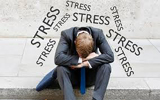Notes on counselling
Beyond the Relaxation Response
Abstract
The burden of the Subconscious1 and terrestrial Inconscience necessitates that the stress reaction be approached from an integral paradigm that includes and surpasses Benson’s Relaxation Response.
Despite all our gadgets and luxuriant lifestyles, our egalitarian democracies and economic policies, stress continues to take its toll all across the globe regardless of whether one hails from an affluent or underprivileged background, whether one is a rationalist or iconoclast, a scientist or charlatan. Given this diversified matrix, one doubts whether the eulogised Relaxation Response can be a panacea in stress-relief. One may argue that the physiology of the human body is the same regardless of the social or cultural background and any therapeutic modality, especially the Relaxation Response, which modulates the body’s autonomic functioning, is bound to be universally effective. However the stress reaction of the human being needs not only to be studied across contemporary cultural crossroads but as a phenomenon that travels across the time-line of history, or, psychologically speaking, along the trajectory of consciousness.
Fight-or-flight response
A retrospective view of the way the stress reaction, a cause of universal malady today, served actually an adaptive purpose in evolution is revealing. If we speculate on the ancestral life of our remote hunter-gatherers of prehistoric times, life in all probability was lived casually and rather simplistically and the only viable threat that one had to face was a physical threat that characterised, in Darwinian terminology, the struggle for existence. Obviously, one could not remain casual if a lion growled; one had to run for one’s life. That meant a shift to a certain heightened state of physiological arousal where the body had to be geared to combat the crisis. The heart had to pump more blood into the system and the heart-rate and blood pressure would increase. The body needed more energy and more glucose had to be made available. The skeletal muscles could not remain in a flaccid state for it had to be ready for action. The attention had to be diverted from the digestive process and the urge for urination and defecation had to be kept in abeyance. The forest was dark and the pupils had to dilate to allow a better vision. The mind had to be focused and alert so that any escape-route would not be missed or any scope for hitting back could be executed.
Naturally, the system had to be supported by a profuse release of adrenaline and cortisol for that fight-or-flight response. In essence, the body had to shift to a catabolic, energy-expenditure mode.
What happened when the lion chased? There could be two outcomes. Either the lion overpowered and the human being succumbed, to be perhaps gobbled up or the latter could get out of danger to a safety-zone that could also be a tree-top. In the case when the lion won the battle, an interesting thing happened. It is known from first-hand accounts since long (from subjects who could be saved at the last moment) that at the time when imminent death looms over a subject, one surrenders totally and does not resist being devoured. Even video-recordings of small animals like rabbits show the same response when chased by bigger animals and after running wildly when the rabbit realises that the game is over, it calmly offers itself to the lion. In other words, the phenomenon of surrender is present in nature too.
If however the subject escaped to a safety-zone, the body returned to a state of normalcy, albeit a state of relaxation, an anabolic mode of energy-conservation. This also needed the mediation of an opposite action of anabolic and stress-relieving hormones, where all the heightened physiological activities returned to normal levels; the blood pressure, heart-rate, digestive functioning, blood sugar levels returned to their baseline functioning. The stress reaction thus served an adaptive value without which the present human civilisation would not have been sustained.
Psychosocial stressors
The problem that we face today is that with the march of civilisation and through the vicissitudes of history, the status of the stressor has changed its denouement. We are no longer threatened by physical stressors but by psychosocial stressors — the long unemployment, the marital discord, the law-suit, the economic recession, the burden of the loan, the drug-addict in the family, the escalated cost of hospitalisation, the expense of education and what not. At the time when the lion was the physical stressor, there could be two outcomes; the lion won and the human subject was eaten up or else the human being outwitted the lion and got saved. However in the modern age, the stressor is no longer a mere physical stressor but a psychosocial stressor which continues to persist, sometimes for years. The law-suit seems to run for ages, the marital discord may move towards a more distressing separation, the drug-addict can have relapses for years, the bad debt may pauperise a family and a malignant illness can drain the family coffers. The problem is that we react to the psychosocial stressor in the same way as we reacted to the physical stressor; we have failed to evolve a new way of coping. As a result, the blood pressure remains raised, the blood sugar remains elevated, the anxiety strengthens as a trait and persists as a state, the depression may engulf not only a single subject but the entire family and life becomes boring, meaningless and alienated. The saga of psychosomatic diseases manifests its chronicity while anxiety and depression impose their anguishing burden on life. Thus the stress reaction that was once adaptive and helped to sustain the civilisation has now become rather maladaptive with the imminent potential to push the civilisation towards catastrophe.
The Relaxation Response
In a real innovative way to counter stress, the Relaxation Response as a wakeful hypo metabolic physiologic state was presented by Herbert Benson, founder of the Mind/Body Research Institute at Massachusetts, in 1975, modulated on the experiential perspective of Transcendental Meditation. The Relaxation Response was conceptually defined as a physical state of deep rest that changed physical and emotional responses to stress and was designed to be the opposite of the fight-or-flight response and actually was demonstrated to reduce trait anxiety and provide stress-relief. Benson designed techniques for progressive relaxation and today many variants of that are creatively used by therapists all over the world in counselling sessions for stress-relief.
One cardinal issue however has not been addressed. The Relaxation Response cannot restore the casual poise of simplicity which was present in the dawn of civilisation when the stress reaction startled life. This is because the human being has to carry today the burden of the collective unconscious that has accumulated in the terrestrial Inconscience through the march of history towards increasingly complex civilisational matrices. Coupled with the burden of the load of the personal unconscious entrenched in what Sri Aurobindo labels as the Subconscious and which the Mother described to increase with all our wrong movements, even the most trivial bordering to vulgarity (1), a mere physiologically beneficial state cannot restore the ideal harmony. Of course, we cannot revert to the primal harmony of early civilisation; we have to move towards an enriched harmony that poises us at a higher equilibrium. The Relaxation Response of Herbert Benson is an important step in that process acting at the physical plane of consciousness. Its importance cannot be devalued as the physical substrate is the basic template on which the non-physical edifice of consciousness has been constructed. Besides, the non-physical planes of our being have to manifest through the physical substrate for expression; a reason why even anxiety and depression have to be assessed along their physical parameters. An integral harmony that not only counters stress but prevents relapses and propels one to higher states of equilibrium where stressors as we know today increasingly fail to elicit responses , is the need of the hour and the object of an integral paradigm of health and psychology.
To effectuate a higher harmony, one needs to act not only at the outer being or surface personality but supplement it by working at the inner being or subliminal personality. There also, one has to work not only at the level of the subtle physical but at the levels of the inner vital and inner mind. At the level of the subtle or inner physical, the relaxation response has to be a gateway for a deeper work in arousing the latent body-consciousness. Sri Aurobindo explains that if this body-consciousness can be aroused, it can be directly worked upon by the will or it can even act independent of the will (2).
At the level of the inner vital, there are multiple tasks to be effectuated. Firstly, calm and equipoise have to be invoked into the system by conquering desires of all sorts. Secondly, the inner vital energy or Prāṇic Śakti has to be tapped. This inner energy is free from the clutches of the mind’s idiosyncrasies and the body’s habits, making it a potent healing force. Thirdly, one can go beyond the emotional bipolarities to access the inner Bliss or Ānanda which is totally motiveless and upholds our true being.
At the level of the inner mind, peace and silence have to be invoked so that the mind is freed and detached from habitual thinking and the mechanically repetitive ruminations that make anxiety a recurrent phenomenon. If only one can shift to a higher poise of cognitive matrix which Sri Aurobindo called the Higher Mind, one can rise up from our ordinary way of thinking with its biases and skews to a field of universal ideation. It is then that we can gradually get less perturbed by the very idea of illness entrenched in the psyche throughout the millennia.
The Psychic Being
Finally the inner being or subliminal personality cannot be sustained by the ego but needs to be maintained by the fourth-dimensional Beyond-Ego principle or soul-essence which Sri Aurobindo named the ‘Psychic Being’. The Psychic Being is the real harbinger of a deeper harmony. If the inner being can be stabilised around the Psychic Being, then an outwardly busy life cannot make a person susceptible to stress-linked illnesses. The Type-A personality who is the professional work-alcoholic falls prey to coronary ailments earlier than others because the outer activity is not balanced by an inner poise. The inner poise needs to be sustained by the Psychic Being that surpasses the ego and represents the quintessence of health in stress-relief (3).
To reiterate, the stress reaction that was once adaptive became maladaptive when the stressors changed their character while the body responded to stress in the same way as it responded when the stressors were purely physical in nature. Herbert Benson’s Relaxation Response restores the state of bodily harmony to pre-arousal levels. However one also has to deal with the human being carrying the burden of the personal Subconscious and terrestrial Inconscience. An integral consciousness-based paradigm includes and exceeds Benson’s approach to restore higher order equilibrium where stressors, physical and psychosocial become ineffective to elicit maladaptive responses.
References
1. Collected Works of the Mother, Volume 4. Cent. ed. Pondicherry: Sri Aurobindo Ashram Trust; 1972, p. 156.
2. Sri Aurobindo. Birth Centenary Library, Volume 22. Pondicherry: Sri Aurobindo Ashram Trust; 1970, pp. 323-4.
3. Basu S. Integral Health. 2nd ed. Pondicherry: SAIIIHR; 2011, p. 168.
1The Freudian unconscious corresponds to the Aurobindonian Subconscious and hence is used interchangeably.
Dr. Soumitra Basu, a practising psychiatrist and member of SAIIIHR, is the Director of a school of psychology, Integral Yoga Psychology. He is also one of the editors of NAMAH.
Share with us (Comments,contributions,opinions)
When reproducing this feature, please credit NAMAH,and give the byline. Please send us cuttings.






